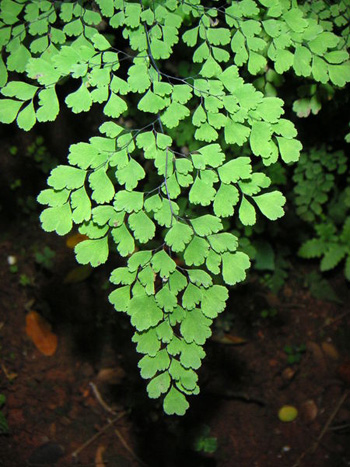Contents:
Common Names | Parts Usually Used | Plant(s) & Culture | Where Found | Medicinal Properties
Legends, Myths and Stories | Uses | Formulas or Dosages | Bibliography
Scientific Names

- Adiantum pedatum L.
- Adiantum capillus-veneris L.
- Filices
- Fern family
Common Names
Adiantum pedatum:
- Five-finger fern
- Maiden fern
- Rock fern
- T’ieh-sien-ts’ao (Chinese name)
Adiantum capillus-veneris:
- Maiden fern
- Common polypody
Parts Usually Used
Leaves
Back to Top
Description of Plant(s) and Culture
Adiantum pedatum:
Maidenhair fern is a delicate perennial fern; the creeping rootstock produces leaves from 1 to 2 1/2 feet high, growing on dark, polished stalks which are forked at the top. Each fork bears 3 to 8 long-oblong pinnae, or leaflets, which are themselves divided into smaller oblong segments, or pinnules, which are incised on the upper margin but entire on the lower side.
Adiantum capillus-veneris:
There are some eighty varieties of this plant, some of which grow abundantly in Canada and the United Sates. Maidenhair is perennial and is found in deep woods and moist, rich soil. This is a very delicate and graceful flowering fern growing from 12-15 inches high, with a slender, polished stalk. The leaves are aromatic and bitterish.
Back to Top
Where Found
Grows in moist, cool places in North American and Asia. Found in rich woods, moist limestone ravines. Maine south to Georgia; Louisiana; west to Oklahoma; north to Minnesota and westward.
Back to Top
Medicinal Properties
Expectorant, anti-rheumatic, demulcent, pectoral, refrigerant, tonic
Back to Top
Legends, Myths and Stories
Maidenhair is used to flavor liqueurs and cordials.
The Romans were fascinated by the unusual qualities of the delicate maidenhair fern when it is immersed in water; under water it glistens with a silvery sheen; but when removed, it is perfectly dry, for water will not cling to it.
ecause of these seemingly magic qualities, the maidenhair fern in Roman mythology was said to represent the hair of Venus when she arose from the foam of the sea, thus the name maidenhair. The plant’s Latin genus name Adiantum comes from the Greek words Adian-tum, meaning “unwetted”.
Back to Top
Uses
Adiantum pedatum:
A decoction made from the leaves of Maidenhair Fern helps clear up coughs and congestion due to colds, asthma, fever, flu, pleurisy, as well as hoarseness and catarrhal problems. Sometimes a constituent in hair rinses, and related species of the fern have been used since antiquity as a hair tonic. May also be used as a scalp lotion to improve hair and stop premature baldness. Native Americans throughout North America used maidenhair as a hair wash to make their hair shiny.
Adiantum capillus-veneris:
Maidenhair Fern is useful in conditions of coughs resulting in colds, nasal congestion, flu, catarrh, hoarseness, asthma, pleurisy, pneumonia.
Back to Top
Formulas or Dosages
Infusion: 1-2 oz. to 1 pint of boiling water may be taken frequently in wineglassful doses.
Decoction: 1 tsp. fresh leaves or 2 tsp. dried leaves with 1 cup water. Take 1-2 cups per day.
Back to Top
Bibliography
![]() American Folk Medicine
American Folk Medicine, by Clarence Meyer, Meyerbooks, publisher, PO Box 427, Glenwood, Illinois 60425, 1973
![]() Chinese Medicinal Herbs
Chinese Medicinal Herbs, compiled by Shih-Chen Li, Georgetown Press, San Francisco, California, 1973.
![]() Culpeper’s Complete Herbal & English Physician: Updated With 117 Modern Herbs
Culpeper’s Complete Herbal & English Physician: Updated With 117 Modern Herbs, by Nicholas Culpeper, Meyerbooks, publisher, PO Box 427, Glenwood, Illinois 60425, 1990, (reprint of 1814)
![]() Eastern/Central Medicinal Plants
Eastern/Central Medicinal Plants, by Steven Foster and James A. Duke., Houghton Mifflin Company, 215 Park Avenue South, New York, NY 10000
![]() The Herbalist Almanac
The Herbalist Almanac, by Clarence Meyer, Meyerbooks, publisher, PO Box 427, Glenwood, Illinois 60425, copyright 1988, fifth printing, 1994
![]() The Herb Book
The Herb Book, by John Lust, Bantam Books, 666 Fifth Avenue, New York, NY. copyright 1974.
![]() Indian Herbalogy of North America
Indian Herbalogy of North America, by Alma R. Hutchens, Shambala Publications, Inc., Horticultural Hall, 300 Massachusetts Avenue, Boston, Massachusetts 02115, 1973
![]() Indian Uses of Native Plants
Indian Uses of Native Plants, by Edith Van Allen Murphey, Meyerbooks, publisher, PO Box 427, Glenwood, Illinois 60425, copyright 1958, print 1990
 The Magic of Herbs
The Magic of Herbs, by David Conway, published by Jonathan Cape, Thirty Bedford Square, London, England. (Out of print)
 Old Ways Rediscovered
Old Ways Rediscovered, by Clarence Meyer, Meyerbooks, publisher, PO Box 427, Glenwood, Illinois 60425, published from 1954, print 1988
![]() Planetary Herbology
Planetary Herbology, by Michael Tierra, C.A., N.D., O.M.D., Lotus Press, PO Box 325, Twin Lakes. WI 53181., Copyright 1988, published 1992
![]() The Yoga of Herbs: An Ayurvedic Guide to Herbal Medicine
The Yoga of Herbs: An Ayurvedic Guide to Herbal Medicine, by Dr. David Frawley & Dr. Vasant Lad, Lotus Press, Twin Lakes, Wisconsin, Second edition, 1988.
![]() Webster’s New World Dictionary
Webster’s New World Dictionary, Third College Edition, Victoria Neufeldt, Editor in Chief, New World Dictionaries: A Division of Simon & Schuster, Inc., 15 Columbus Circle, New York, NY 10023
 The Rodale Herb Book: How to Use, Grow, and Buy Nature’s Miracle Plants (An Organic gardening and farming book)
The Rodale Herb Book: How to Use, Grow, and Buy Nature’s Miracle Plants (An Organic gardening and farming book), edited by William H. Hylton, Rodale Press, Inc. Emmaus, PA, 18049., 1974
